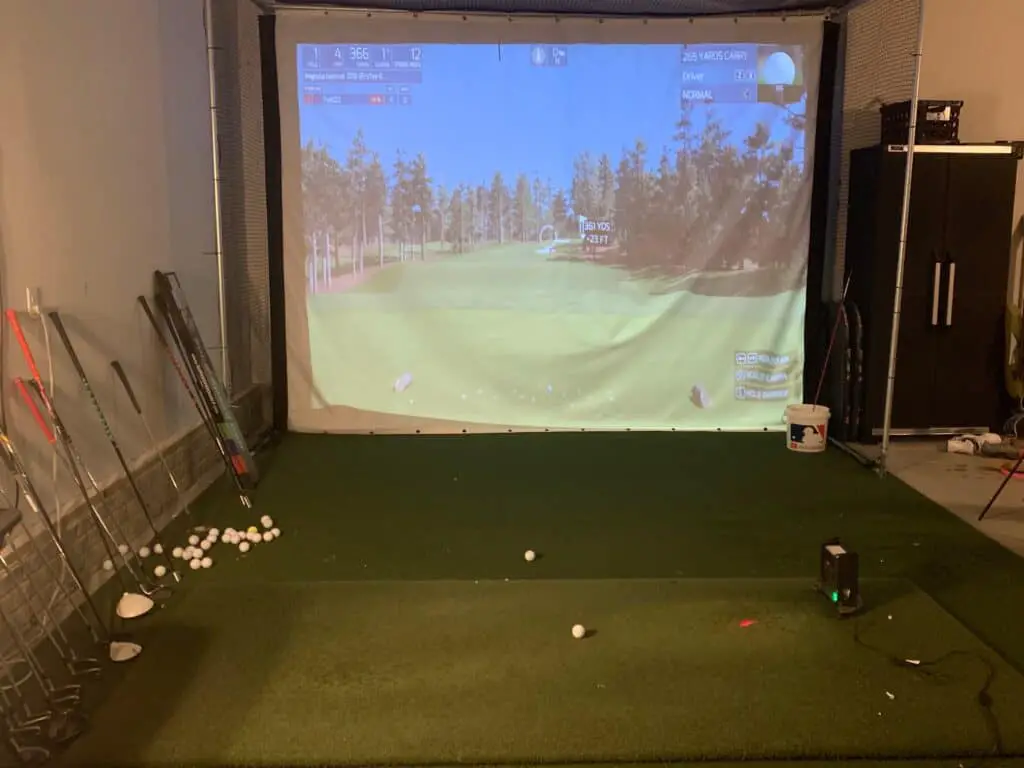Have you ever hit the shot that feels extremely pure?
Most golfers seek that perfect feeling when they compress the ball and it seems to fly just perfect!
We are all chasing that consistency from round to round with that perfect feeling shot that keeps us coming back for more.
That feeling is the right combination of angle of attack, compression, centeredness of hit and ideal spin rate to have the golf ball fly just right!
The great news is that the golf ball doesn’t know whether Tiger Woods or you are hitting the ball. So what is the key to gain this consistency and have it occur more often? I will provide some drills to help you become a better ball striker which includes hitting down on the golf ball
Should I Hit Down on The Golf Ball?
Yes, especially with the irons the angle of attack should be down and through the golf ball, but too much angle of attack can lead to poor spin rate and poor results. The key is to find the right combination of hitting down, but with the right angle of attack.
The drills below will help you get to the place where you are at an ideal angle of attack to produce quality spin rate and the right compression.
Quick review of the fundamentals of golf:
- Fundamental #1: The golfer’s ability to control the bottom of the golf swing. The best golfers will hit the ground in the intended spot, close to 100% of the time.
- Fundamental #2: The golfer’s ability to control the curve of the golf ball. The best golfers are able to start the ball to the right or left of the target line and have the ball curve towards the target without the ball over-curving past the target.
- Fundamental #3: The golfer’s ability to have enough power to play the golf course. This means they are able to hit the ball far enough to play the course in regulation.
You will see that the first fundamental in golf is being able to control the bottom of the golf swing. Without the right control at the bottom, it is difficult to become the ball striker you want and need to be to find that consistency that you strive for.
Drills To Hit Down On The Golf Ball (3 Drills)
Drill #1: Low Point Control Drill
Whether you are hitting an 8 iron, a 4 iron or a pitching wedge, the first key is to be able to control the low point of the golf swing. This leads to solid contact, predictable distances and the ability to strike the ball like a low handicap golfer. The lower the handicap of the golfer, the better chance of the golfer doing this rather easily and at a high level of consistency.
The high handicap golfer will often struggle with controlling the low point, leading to fat shots or thin shots due to the weight being in the wrong location, centers getting too far back or too far forwards or an early casting of the golf club. Here is an excellent drill to utilize to help you develop your low point control:
Here the the steps to take to complete this drill:
- Paint a 2-3 yard long line with some yard paint.
- Place the wiffle ball on the line.
- The goal is to have your divot start just on the target side of your line.
- Go ahead and hit shot after shot, working on controlling your low point and your entry into the ground.
- Assess your success rate out of 20 times and write it down.
- Complete this drill daily for several weeks and see if your game improves at the course.
If you start to hit the ball poorly at any point on your golf journey, return to this drill and keep it simple.
One quick tip: if you are struggling to control your low point, go ahead and set up with 60% of your weight on your front leg. Keep your head centered without a big shift off the ball and turn more around your front leg. This will help keep your centers in place and allow you to control the low point.
Many golfers struggle with the low point because they don’t get their weight back to their front side early enough and end up casting the club.
Drill #2: Weight on Front Leg Drill
Often times when completing a drill, the best route is to take something less than a full swing to develop the feeling and mechanics necessary to then take it to the full swing. I have found this drill to be one of my go to drills to keep everything simple and compressing the ball solid.
Below is an example of the building blocks this drill can be in your journey to develop a consistent golf swing!
Here the the steps to take to complete this drill:
- Grab a wedge or short iron.
- Set up with your weight forward (60-70%) on the front leg.
- Take the club halfway to 3 quarters of the way back.
- Work on hitting down and through the ball.
- Once you start to control the low point and compression of the ball, focus on the start linke (fundamental #2 above) to take your game to the next level.
The goal here is to compress the ball with your hands ahead of the contact point, creating some lag tension in your swing. If you cast the club from the top, you will lose the angles and struggle to truly compress the ball.
Drill #3: Two Ball Drill
Here is another drill to help you hit down on the ball and compress the ball. This drill will help you produce the lag needed. I could literally stand and do this drill all day as it helps to develop lag, properly upper body rotation and hitting down and through the ball. My swing fault is moving in front of the ball and manipulating my hands to hit the ball straight.
Here the the steps to take to complete this drill:
- Go ahead and place a golf ball you are going to hit.
- Set up another ball about 1 foot behind it.
- Place your club on top of the ball 1 foot behind.
- Take a ½ swing, maintaining your lag down and through the ball.
- You should set up with your weight about 60-70% on your front leg.
This drill is great for the golfer that moves forward and casts the club early, making it difficult to hit down and through the ball. I have used this drill where I almost feel like I move my upper body back, which helps you maintain your lag so you don’t have to throw the clubhead as your body moves too far forward.
Resource: Take Your Game to the Next Level with a Stock Shot Drill!
Asses and Improve Your Swing
Feedback is the key to learning. If you lack feedback, you will struggle to learn anything in life, including the golf swing. My number one route for feedback is my SkyTrak launch monitor. I am able to monitor the following:
- Carry and Total Distance
- Ball Speed
- Launch Angle
- Spin Rate
- Spin Axis
This gives me the feedback needed to know how far I am hitting it, my start lines, how I am spinning the ball and my overall launch angle.
These numbers are vital to helping me groove a stock shot that I prefer to hit, which is a baby draw. The shot that starts right and curves back to the target without over curving.
The portable launch monitors have become more and more affordable for the amateur golfer. You do not need the 16,000 dollar option, when for most amateur needs the entry level launch monitor is a great option and provides some excellent feedback information to assess and improve your golf swing!
Check out these 3 quality options below:

Take Action – What You Can Do Today to Get Better
What does this mean for you? I believe in the following recipe to get better:
1 – Improve your motion in the golf swing by identifying a golf instructor. Here are some options:
Here is a list of golf instructors that we have reviewed:
2 – Train to swing faster and improve your swing speed. Here are some options:
Looking to gain more Speed and Distance in your swing. Two Options:
3 – Understand course strategy and work to break through your next barrier. Here is a series on breaking through:
We have provided guides on how to break 100, 90, 80 and 70. Check out more below, if interested.
4 – Practice Frequently
Did you know that I build a golf simulator in my garage and have played over 500 rounds of golf on my SkyTrak system? It has been a game changer and one worth checking out. Here are some of my other posts on golf simulators frequently asked questions:
- Is a Golf Simulator Worth It?
- How to Build a Golf Simulator?
- What is the Best Golf Simulator?
- Golf Simulator Accessories?
- How to Build a Golf Simulator for under $7000
- Top 11 Reasons to Buy a SkyTrak
- How to Build a Golf Simulator for Under $1000
- Why Build A Golf Simulator?
- What Space is Needed?
- Can A Golf Simulator Improve My Game?
- How Much Does A Golf Simulator Cost?
- Don’t Forget to Check out our 15 best golf swings of all time.
